We have analyzed our comprehensive view of the 7 Best Celestron Binoculars. You can see the objects you are seeing more clearly with the best Celestron binoculars during these situations. They draw you closer to the far items and enlarge the tiny ones so you can view them in amazing detail. For outdoor enthusiasts who enjoy spending time in nature, binoculars provide a whole new perspective on the world.
In the optical sector, Celestron is a well-known brand. The company has expanded to rank among the top producers of a wide range of lenses and accessories linked to lenses, such as binoculars and telescopes.
Choosing a set of the 7 Best Celestron Binoculars that precisely suits your demands is difficult because there are so many models on the market right now. Here is a list of the 7 best Celestron binoculars on the market, to assist you in making an informed purchase. These binoculars are easy to use, long-lasting, and adaptable.
7 Best Celestron Binoculars
1) Celestron SkyMaster Giant 15×70 Binoculars

Known for their large aperture and high magnification, these are often favored for stargazing and astronomy. With these binoculars, you can see everything in the field of vision while wearing spectacles because of their generous 18mm eye relief, which allows you to stay comfortably away from your eyes. These binoculars have a true field of 4.4 degrees or about nine times the angular diameter of the full Moon.
Porro prisms manufactured of BaK-4 crown glass are used in the SkyMaster 15x70s and most other high-quality binoculars. This is better than the more common BK7 prisms found in cheaper or subpar items. Cheaper BK7 prisms are usually not as well-made as BaK-4 prisms, and binoculars that employ these prisms usually don’t have undersized prisms that could vignette or clip the field of view.
With only the smallest clipping around one edge of the exit pupil—not enough to impair views—the aperture of these binoculars is a true 70mm and hasn’t been shut down internally by much. The exit pupils are almost perfect circles.
Features
- Adaptable Tripod
- The Porro Prism Style
- Rubber-Coated Structure
- At 1000 yards, the field of view is around 231 feet.
- Lenses with anti-reflective coatings
- Completely multi-coated for improved clarity and contrast
- The exit pupil measures about 4.7 mm.
- Eye relief typically measures 18 mm.
Pros
- Durable
- Long Eye Relief
- Easy to handle
- Affordable
Cons
- Hefty and large
- Limited Viewing Angle
2) Celestron Nature DX 8×42 Binoculars
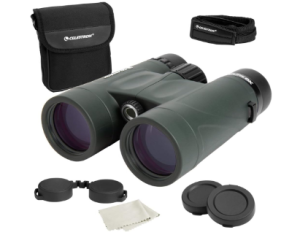
A versatile option suitable for birdwatching, nature observation, and other outdoor activities. They offer a good balance of magnification and field of view. Phase coating improves contrast and resolution in Nature DX’s premium BaK-4 prisms. Phase-coated prisms and completely multi-coated lenses maximize light transmission throughout the optical path to produce brighter images in low light.
The Nature DX 8x42mm combines functionality and portability with its 8x magnification and 42mm objective lenses. Grab and track your target fast with the expansive field of vision. Alternately, use a 6.5-foot close focus to study adjacent objects like plants and insects.
Your Nature DX binoculars are protected from harm with a sturdy polycarbonate housing that is hardened with rubber, all without adding bulk to your frame. Even for people who wear glasses, properly positioned eyes are ensured by twist-up eyecups with multiple stops. These nitrogen-purged, waterproof, and fog-proof binoculars are resistant to the weather. They easily fit in an enormous pocket or glove box and are simple to pack, even for extended travels.
Features
- Superior caliber glass
- At 1000 yards, the field of view is around 388 feet.
- Eye Relief is Typically Between 17 and 18 mm
- Complete multicoating
- Both fog proof and waterproof
- Eyecups with a multi-stop function that twists up
- Rubber-coated polycarbonate structure
- BaK-4 prisms covered in phase
- 8 times magnification
Pros
- Superior construction quality
- Flexibility
- Compact and transportable
- Reasonably priced
- Simple to use
Cons
- Relatively heavy
3) Celestron TrailSeeker 10×42 Binoculars
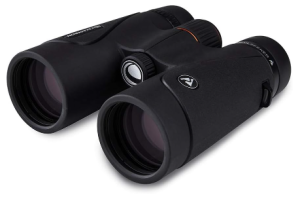
Designed for outdoor enthusiasts, these binoculars provide a higher magnification with a durable and waterproof construction. The front lenses’ diameter is 42mm. An image seems brighter as more light enters the binoculars thanks to a bigger objective lens. The roof prism design of the TrailSeeker binoculars allows for more compactness and streamlining.
With its exceptional optical qualities, this premium prism glass is renowned for producing images that are clear and sharp. The breadth of the region visible through the binoculars at a given distance is known as the field of vision. Because the TrailSeeker binoculars are frequently made to be waterproof and fogproof, they can be used in a variety of weather situations. These are helpful for people who wear glasses because you can change the eye comfort.
This is the closest point at which an item can be focused with binoculars. It applies to studying issues up close. the distance, when the full field of view is visible, between the eyepiece and your eye. For those who wear glasses, enough eye relief is essential for comfortable viewing.
Features
- A magnesium alloy framework
- The 42mm objective lens diameter
- 10x magnification
- Twist-up metal eyecups with several stops
- Upscale BaK-4 prisms
- multicoated lenses
- Both fog- and water-resistant
- Durable rubber armor
Pros
- Exceptional quality of construction
- Adaptability
- Small and lightweight
- Inexpensively priced
- Easy to use
Cons
- Reasonably hefty
4) Celestron Outland X 10×42 Binoculars
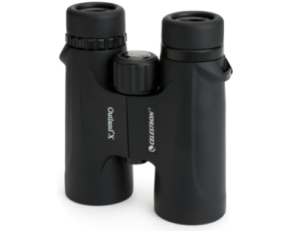
A budget-friendly option with good optics, suitable for general-purpose use such as birdwatching, sports events, and hiking. The distance between the eyepiece and your eye, when the whole field of view is visible, is known as eye relief. Those who wear glasses should pay special attention to this. Generally speaking, the eye relief of the Celestron Outland X 10×42 Binoculars is pleasant.
The width of the area that can be seen at a distance of 1000 yards with binoculars is known as the field of vision. Typically, this data is given in feet. The Celestron Outland X 10×42 Binoculars’ field of vision varies depending on the model; for more information, see the product details individually.
The closest distance at which the binoculars can concentrate on an object is known as the close focus distance. This can be useful for observing subjects that are close by. These binoculars usually have a narrow focus distance of about 14 feet.
Features
- Optics with several coatings.
- Water- and fog-resistant.
- Rubber covering with protection.
- Adjustable eyecups that twist up quickly.
- Neoprene Carrying Case with Moisture Resistance.
Pros
- It’s reliable and durable
- Easy to monitor
- Come with a carrying case
Cons
- Have a longer minimum focus distance
5) Celestron Granite ED 10×42 Binoculars
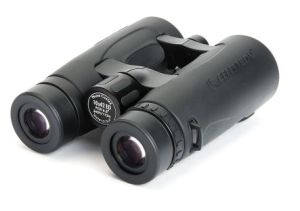
These binoculars are known for their extra-low dispersion (ED) glass, providing sharp and high-contrast images. Usually built tough and resilient, these binoculars feature a protective rubber coating for improved shock resistance and a sure grip. Users can tailor the eye relief with adjustable eyecups, making it comfortable for both glasses-wearers and non-wearers.
Sharper and more detailed images are produced by reducing chromatic aberration through the use of Extra-Low Dispersion glass in the lenses. Compared to porro prisms, roof prisms allow for a more streamlined and compact design, which is likely the case with these binoculars.
The breadth of the region visible through the binoculars at a given distance is known as the field of vision. Generally speaking, surveying a landscape or watching rapidly moving objects requires a wider field of view. Numerous top-notch binoculars, such as the Celestron Granite ED series, are made to be waterproof and nitrogen-filled to avoid internal fogging in the event of temperature fluctuations.
Features
- Enhanced light transmission through full multi-coating
- High-reflectivity BaK-4 Prisms with Brilliant Colors
- Harness Strap for Binoculars
- The Focus Knob’s metal structure
- Long-lasting and precisely movable twist-up eyecups
- Water- and fog-resistant
Pros
- Flexibility
- Clearly defined optics
- Robust design
- Portable and simple to operate
Cons
- Heavy
6) Celestron Echelon 20×70 Binoculars
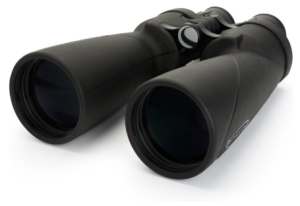
Ideal for long-range observations, these binoculars offer high magnification and are suitable for both terrestrial and astronomical viewing. A 20x magnification and a 70mm objective lens diameter are indicated by the “20×70” designation. This combination works well for reasonably detailed observations of far-off objects.
BaK-4 prisms are renowned for their excellent optics and light transmission, and these binoculars likely employ them. To improve the brightness and contrast of the image, they may use fully multi-coated lenses. Because certain types are waterproof or water-resistant, they can be used in a variety of weather situations.
These binoculars might be tripod-adaptable to improve stability when used for extended periods. Users can adjust the eye relief for a comfortable viewing experience, especially for those who use glasses, thanks to the widespread availability of adjustable eyecups.
Features
- Intended to be used in dimly lit environments
- Delivers the Echelon Series’ highest magnification.
- Excellent BaK-4 prisms
- Composed of an aluminum alloy
- Including a premium waterproof hard case
- Employ a separate eye focus mechanism
- Possess a 19.5 mm eye relief
Pros
- Elevated Magnification
- Big Objective Lenses
- Simple to keep an eye on
- Creating long-lasting items
Cons
- Needs Steady Mounting
7) Celestron Nature DX 10×56 Binoculars
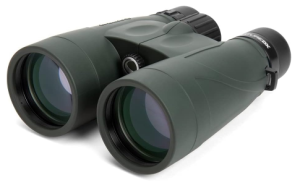
Another option from the Nature DX series, these binoculars offer a larger objective lens for improved low-light performance, making them suitable for dawn or dusk observations. The weight of the binoculars is around 36 ounces, which may not be comfortable for extended periods of use.
For improved stability during extended observation, the binoculars can be fixed on a tripod.
The quantity of light that may enter the binoculars depends on the size of the objective lenses, which affects brightness and low-light performance. The binoculars are lighter and more portable thanks to the roof prism construction.
This measurement shows the width of the field of view at a distance of 1000 yards as seen via binoculars. This is the closest point at which an item can be focused with binoculars. the separation between your eye and the eyepiece at which the complete field of view is visible.
For sharper, more vivid images, multi-coated lenses improve light transmission while reducing glare. Because of their weather-resistant design, these binoculars can be used in a variety of weather situations.
Features
- 6.5 feet is the close focus distance.
- At 1000 yards, the field of view is 288 feet.
- It weighs roughly 36 ounces.
- Complete multicoating
- Both fog- and water-proof
- Movable eyecups with a multi-stop feature
- Armoured polycarbonate housing with rubber
- BaK-4 prisms covered in phase
Pros
- Road field of vision
- Adjustable tripod
- Not heavy
- Reliable
Factors to consider when choosing the 7 Best Celestron Binoculars
Magnification
Think about how much magnification you’ll need for your intended purpose. More magnification yields finer details, but without a tripod, it can also cause a smaller field of vision and a shakier picture.
Objective Lens
The amount of light that enters the binoculars and affects image brightness is determined by the size of the objective lens. Brighter images can be obtained with larger objective lenses, particularly in low light.
Field of View
A larger field of view is advantageous for sports events or pursuits like birdwatching spots events or pursuits like birdwatching, a larger field of view is advantageous. It lets you see farther without requiring you to adjust your binoculars. The breadth of the field of view (FOV) was observed with binoculars. Sporting events and bird viewing benefit from a broader field of vision. However, a smaller field of view is usually the consequence of increased magnification.
Eye Relief
This is crucial, particularly for people who wear glasses. You can see the complete field of view without straining your eyes when there is adequate eye relief, which guarantees pleasant viewing. When the full field of view is visible, this is the distance between the eyepiece and your eyes. Wearers of spectacles should seek out greater eye relief to prevent vignetting and guarantee a comfortable viewing experience.
Create Quality
Take into account the binoculars’ endurance and construction quality. A sturdy construction, plush grip, and premium materials all add to the product’s overall usefulness and durability. Think about the building supplies, general durability, and build quality. Rubber armor is one of those features that offers a nice grip while offering shock and impact protection. For outdoor use, designs must be both fog- and waterproof-proof.
Weight and Size
Select a weight and size based on how you want to use it. Larger binoculars might be better suited for stationary observations, but smaller, lighter binoculars are more practical for outdoor activities like trekking. Your planned use may determine how important the binoculars’ weight and size are. In comparison to larger, heavier variants, compact and lightweight devices are more portable but may sacrifice some capabilities.
Prism Type
Typically, roof or porro prisms are used with binoculars. Roof prisms can be more costly but offer a more streamlined form. Porro prisms may be bigger but can be more reasonably priced and provide a better sense of depth.
Read Also:
7 Best Swarovski Binoculars For Hunting
FAQs of the 7 Best Celestron Binoculars
- Can I wear glasses and use Celestron binoculars?
Indeed, many Celestron binoculars have twist-up eyecups that make them comfortable for those who wear glasses and others who don’t. To select the most comfortable viewing posture, you can adjust the eyecups.
- How should my Celestron binoculars be maintained and cleaned?
Celestron typically offers instructions on how to maintain and clean its optics. Using a soft, lint-free cloth and a lens cleaning solution is advised. Refrain from using anything abrasive that could scratch the lenses.
- Are Celestron binoculars available with accessories?
Celestron frequently provides lens covers, neck straps, tripod adapters, and carrying cases for its binoculars. Additionally, certain versions might be tripod-adaptable for longer viewing sessions.
- Can one use Celestron binoculars for astronomy?
Indeed, Celestron has a selection of binoculars made especially for astronomy. These versions are perfect for stargazing because they often have larger objective lenses and lower magnifications.
- Are there warranties available for Celestron binoculars?
For binoculars, The 7 Best Celestron Binoculars usually offer a limited lifetime warranty. Verifying the warranty details for the specific model you buy is advisable, as warranty periods could differ.
Conclusion
I hope this list of the 7 Best Celestron Binoculars has been very helpful. Think about the objective lens diameter and magnification that best fit your intended application. A steadier hand or tripod may be needed for prolonged use, and more magnification may result in a smaller range of view, so it’s not always preferable. I hope you have a happy hunting season.

